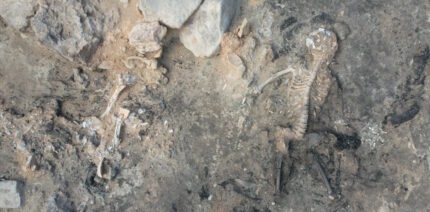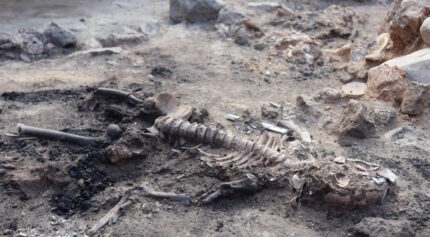 Archaeologists have discovered preserved brain and skin tissue on the skeletal remains of a man at the Bronze Age settlement of Tavşanlı Höyük in western Turkey. The deceased died in a major attack on the settlement that took place around 1700 B.C. and his body burned when the city was set on fire. The high heat carbonized and preserved the brain inside his skull and a section of skin between his chest and abdomen. Only four or five instances of preserved brain remnants have been found in Anatolia, and this is the first time carbonized human skin has been discovered in Turkey.
Archaeologists have discovered preserved brain and skin tissue on the skeletal remains of a man at the Bronze Age settlement of Tavşanlı Höyük in western Turkey. The deceased died in a major attack on the settlement that took place around 1700 B.C. and his body burned when the city was set on fire. The high heat carbonized and preserved the brain inside his skull and a section of skin between his chest and abdomen. Only four or five instances of preserved brain remnants have been found in Anatolia, and this is the first time carbonized human skin has been discovered in Turkey.
The archaeological team was excavating a mudbrick and wood structure from the era of the attack, identified by a large fire layer. Within the layer, they found the skeletal remains of two men, one younger (aged 15-18), one older (aged 40-45) under the rubble of the house. The older man had been trapped in the middle of the room, pinned by a wooden shelf and dozens of earthenware pots that collapsed on him when the building fell. The young man was at the door, perhaps trying to escape, when he was crushed by collapsed rubble.
 Because of his location at the entrance to the building, the young person’s skeleton was exposed to much higher temperatures than the older man’s. The high degree of heat whitened some of his bones and carbonized the skin and brain.
Because of his location at the entrance to the building, the young person’s skeleton was exposed to much higher temperatures than the older man’s. The high degree of heat whitened some of his bones and carbonized the skin and brain.
In the presentation prepared by the excavation director, Prof. Dr. Erkan Fidan, who is also the Department Head of Archaeology at Bilecik Şeyh Edebali University, and the deputy director of the excavation, Dr. Nihan Naiboğlu, who is an Assistant Professor at Nişantaşı University, it was stated that Tavşanlı Mound, with its 8,000-year history, is the oldest settlement in Kütahya and one of the largest Bronze Age settlements in Western Anatolia, covering an area of 45 hectares. It was also mentioned that Tavşanlı Mound was likely the capital of the region….
The attack on the settlement was very sudden and it seems like the northeastern edge was particularly vulnerable to attack. All of the weapons — daggers, spearheads, arrows — found there are in the destruction layer. Archaeologists believe the settlement was besieged by a greater military power and the entire city was burned to the ground.
This excavation project began in 2021 and is planned to continue for at least 30 years. The team hopes to discover who attacked the city and why in future dig seasons.
Has been unearthed, who in fact seemed to have been attacked in the first place?
As far as the attackers are concerned … Hittites, Phrygians, Persians, Macedons, Romans, Byzantion, the Sultanate of Rum, Armenians, Greeks, Germiyanids, Ottomans…
I reckon, it’s only the TURKS that seem to have a “rock solid” alibi 😀